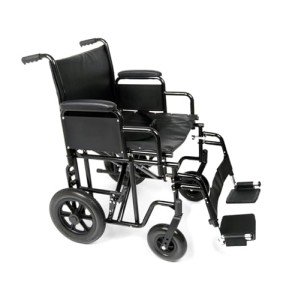Bariatric Transport Wheelchair
Developed to be pressed by caretakers, transport chairs feature smaller front wheels and larger rear wheels. They are a popular choice for users with restricted mobility who can not stroll separately.

When shopping for a lightweight bariatric transport wheelchair, consider the user's requirements and how they'll use the chair. Likewise, measure any doorways and other spaces the chair will travel through.
Seating
Bariatric transport chairs feature a large 22 to 36 inch wide seating area that accommodates extra-large users. The chair seat is made from breathable nylon and includes cushioned arms that can be removed and swing-away footrests. Unlike basic wheelchairs, which are perfect for typical body weights, bariatric chairs have much heavier frames built from enhanced products and bigger rear wheels that make it easier to push them. Speak with a mobility expert to discover more about your alternatives and to figure out which type of wheelchair is ideal for you. Bariatric wheelchairs are typically covered by insurance providers like Medi-Cal if your medical condition fulfills their protection requirements.
Frame
Bariatric transport wheelchairs use heavy-duty frames made of reinforced products like steel and have wider seats than basic wheelchairs. They are developed for people with higher body weights and can hold an optimum weight capacity of 700 pounds. They also have larger rear wheels, which make them simpler for caretakers to press. Bariatric wheelchairs are often covered by insurance such as Medi-Cal, depending on the client's particular medical needs and medical diagnosis. Ask a health care professional or mobility specialist to assist choose the best chair for your unique requirements.
Click here for more details. Medline Bariatric Transport Chair. Deep Red Hammertone Frame.
Weight
While standard wheelchairs have lighter frames and smaller wheels, bariatric transport chairs include heavier-duty products and a wider seat to accommodate users who weigh more than average. Because of their specialized style and building and construction, they tend to cost more than standard chairs. Nevertheless, some insurance programs like Medicare and Medi-Cal might cover the cost of these chairs if the user meets the requirements for coverage. To read lightweight bariatric wheelchair which chair is ideal for you, contact a rehab expert today.
Wheels
Bariatric transport wheelchairs have bigger rear wheels than basic models, making them much easier to push. They're often utilized in healthcare facilities and home settings, where the chair is pressed by caregivers. The extra-large rear wheels also permit the chairs to navigate a range of surface, consisting of outdoors.
Basic wheelchairs normally have smaller sized wheels, that make them more maneuverable indoors however less appropriate for everyday usage on outdoor streets and other surfaces. Mobility specialists advise speaking with a doctor or mobility specialist to select the best wheelchair for your specific needs and objectives.
This durable, nylon enhanced steel transport chair supports clients up to 500 pounds and features a roomy 22" seat, cushioned desk-length armrests, swing-away footrests and hand brakes. The 12-inch rear wheels make sure a smooth ride in any environment.
